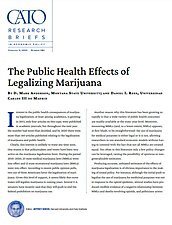Clearly, this interest is unlikely to wane any time soon. One reason is that policymakers and voters have been very active on the marijuana legalization front. During the period 2010–2020, 23 state medical marijuana laws (MMLs) went into effect and 12 state recreational marijuana laws (RMLs) went into effect. According to recent public opinion polls, two out of three Americans favor the legalization of marijuana. Given this level of support, it seems likely that more states will legalize marijuana in coming years. Several U.S. senators have recently said that they will push to end the federal prohibition on marijuana use.
Another reason why this literature has been growing so rapidly is that a wide variety of public health outcomes are readily available at the state-year level. Moreover, measuring MMLs (and, to a lesser extent, RMLs) appears, at first blush, to be straightforward: the use of marijuana for medical purposes is either legal or it is not, allowing researchers to use standard economic models without having to contend with the fact that not all MMLs are created equal. Too often in this literature only a few policy changes can be leveraged, raising the possibility of spurious or nongeneralizable estimates.
Producing accurate, unbiased estimates of the effects of marijuana legalization is of obvious importance to the making of sound policy. For instance, although the initial push to legalize the use of marijuana for medicinal purposes was not in response to the opioid epidemic, several studies have produced credible evidence of a negative relationship between MMLs and deaths involving opioids, and politicians across the ideological spectrum have referred to these studies when explaining their support for legalizing both medical and recreational marijuana. Not only do published estimates appear to inform the complicated process of crafting policy but decisions at the state and local levels ultimately determine whether legalization affects just a small portion of the population—for instance, those who are suffering from cancer or diseases that affect the immune system (e.g., multiple sclerosis)—or whether it means that everyone over 21 years of age gains access.

